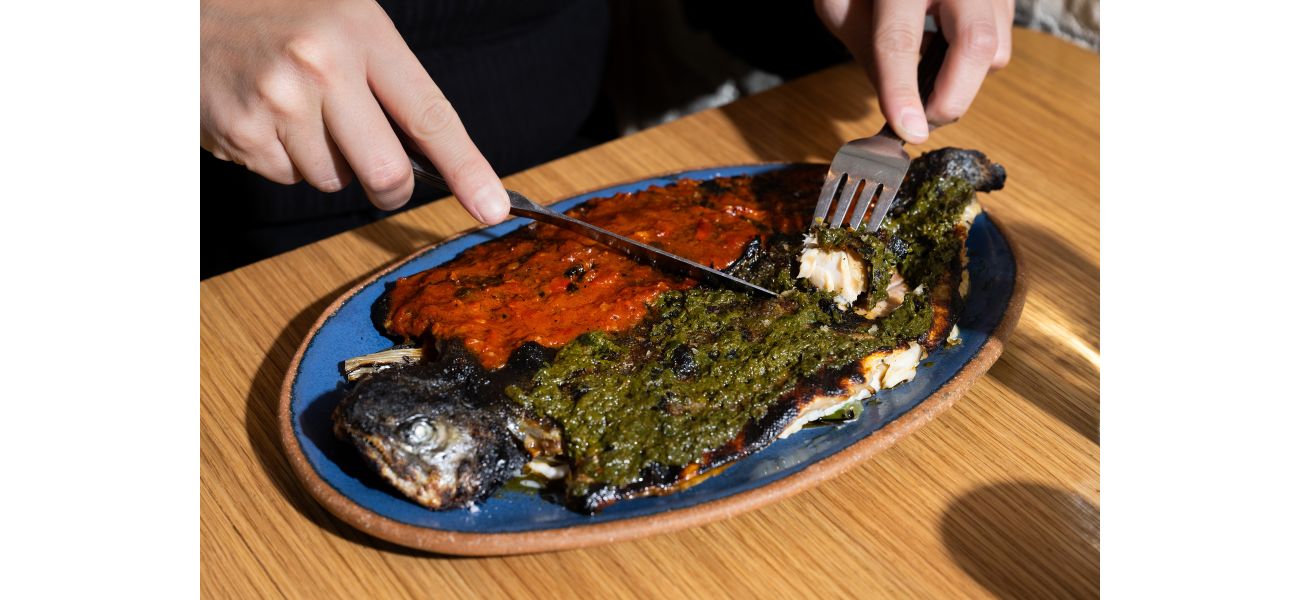Discover the recipe for Pescado a la Talla, a popular dish served in red and green sauces.
Photo-worthy fish from Mexico City's Contramar is now a popular dish at restaurants nationwide for its delicious taste.
November 14th 2024.

Priya Krishna, a writer for The New York Times, visited Contramar, an airy restaurant in Mexico City's chic Roma Norte neighborhood. The entire restaurant was adorned with paintings of colorful fish, and Priya couldn't help but notice an imposing whole fish on almost every table. It was painted with bright red and green sauces, making it a photogenic masterpiece. As she sat down to enjoy her meal, a server informed her that it was their signature dish, pescado a la talla Contramar. The server also mentioned that it was customary for guests to take a picture of the dish before indulging, as it had become an Instagram sensation.
The creator of this dish, chef Gabriela Cámara, has made it synonymous with Mexico City and her restaurant. However, the popularity of this dish has spread far and wide, with variations being served in restaurants across the world, from Cincinnati to Greece. It has become one of the world's favorite restaurant dishes, with its distinctive technique and presentation giving it staying power beyond the usual 15 minutes of social media fame.
One of the reasons for its widespread popularity is its versatility. The dish is instantly recognizable and can be easily adapted to different cuisines and ingredients. Chef Nok Suntaranon, who visited Contramar and was blown away by the dish, created a Thai-inspired version for a pop-up event. Other restaurants, like Majordomo in Los Angeles and Birch in Milwaukee, have also put their own spin on the dish using local ingredients and flavors.
But despite its international fame, chef Cámara is quick to point out that she did not invent pescado a la talla. She simply popularized it with her unique presentation. The traditional dish, found on the Pacific coast of Mexico, is made from fresh-caught fish that is grilled and rubbed with a dried chile sauce. However, in Mexico City, where Contramar is located, this style of cooking was not common in restaurants. Cámara saw an opportunity to elevate this dish by using a delicate fish called huachinango and adding a garlic and parsley sauce on one side, inspired by her Italian heritage.
The dish was an instant hit and soon became an iconic representation of Mexican cuisine. Cámara's use of bright, vibrant sauces and communal dining style also reflects a shift in American tastes, away from traditional French sensibilities. As chef Kyle Knall from Birch puts it, "this is a dish that represents what we want to eat, and how we want to eat."
The popularity of this dish has also played a crucial role in putting coastal Mexican food and Mexico City on the culinary map. Food and travel writer, Cristina Alonso, believes that Contramar was a game changer and that pescado a la talla has become one of the defining dishes of Mexico.
Its fame has also helped shift perceptions of Mexican cuisine in places like England, where Mexican menus are still dominated by burritos and sour cream. Chef Sam Grainger, from Madre restaurant in Manchester and Liverpool, serves their version of the dish and believes that it is a great way to showcase a different side of Mexican cooking.
But with fame comes imitation, and some chefs worry that the dish is becoming too trendy and losing its uniqueness. Chef Wes Avila from Ka'teen in Los Angeles admits to putting the dish on his menu without even realizing he was imitating Cámara. He believes that food is becoming homogenized and that it is harder to find true uniqueness in the culinary world.
However, despite her role in making this dish famous, Cámara has mixed feelings about its impact. She is proud of its success but also regrets that it took a white chef to make a dish that Mexicans have been eating forever, popular. She hopes that people will look beyond this trendy dish and appreciate the diversity and complexity of Mexican cuisine.
In the end, pescado a la talla may be the flavor of the moment, but as Cámara puts it, "trendy things, one day, are not trendy anymore." Mexican food is so much more than just a trend - it is a rich and diverse cuisine that deserves to be celebrated for its cultural significance and delicious flavors.
In the bustling city of Mexico City, there is a popular restaurant called Contramar, located in the trendy neighborhood of Roma Norte. It's known for its big, airy space and delicious food, particularly their signature dish - a whole fish painted with bright red and green sauces. This dish, called pescado a la talla Contramar, has become synonymous with the restaurant and its chef, Gabriela Cámara. It's so visually appealing that when a server brings it to your table, they instinctively pause, waiting for you to take a picture - just like all the other guests do.
But Contramar isn't the only place where you can find this famous dish. It has inspired versions at restaurants all over the world, from Cincinnati to Brooklyn, and even as far as Manchester, England and Antiparos, Greece. What started as a take on a traditional Mexican coastal dish has now become a global sensation, with dozens of homages and countless Instagram posts. It's the "it" dish of the moment, like the miso black cod or the Cronut - a dish that stands out with its unique technique and presentation, and has staying power beyond the usual 15 minutes of social media fame.
Chef Nok Suntaranon, from Kalaya restaurant in Philadelphia, raves about the dish, calling it one of the best things she's ever eaten. She even created her own Thai-inspired version for a pop-up event. And she's not the only one - chefs all over the world are putting their own spin on it. At Majordomo in Los Angeles, they serve an homage with chicken instead of fish and two different sauces - a ginger-scallion sauce on one side and a Korean-inspired chili sauce on the other. In Milwaukee, chef Kyle Knall pays tribute to the dish with local trout rubbed with tomato and pepper pastes. He believes that the widespread popularity of the Contramar fish reflects a shift in American tastes towards vibrant flavors and communal dining, rather than the old-school French sensibilities.
But while Chef Cámara is credited with popularizing the dish, she is quick to point out that she did not invent it. She simply elevated it with her unique presentation. The traditional coastal Mexican version consists of grilled fish rubbed with a dried chili sauce, but when Contramar opened in 1998, this simple catch-of-the-day style of cooking wasn't common in Mexico City restaurants. Cámara saw the potential in this dish and built her version around huachinango, a delicate fish from the snapper family. To make it stand out, she spread one side of the fish with the traditional chili rub and the other with a garlic and parsley sauce, inspired by her Italian heritage. The result was a visually stunning dish with vibrant Mexican colors.
And it was an instant hit. Cámara was surprised when she started seeing her fish on menus in the United States and beyond. Chefs were even presenting her with her own dish, not realizing that they were imitating her. This is when Mexican food really started gaining popularity, and in recent years, the pandemic has only accelerated its global reach. But while Cámara is proud of the dish's success, she also regrets that it takes a white chef to make a traditionally Mexican dish popular.
Cámara hopes that people will look beyond the Instagram-worthy dish and delve deeper into Mexican foodways. The Contramar fish may be the flavor of the moment, but she believes that Mexican food is so much more than just a trend. And she's not alone in this sentiment - other chefs, like Gerardo Estevez from Theodora in Brooklyn, also see it as a sign of cultural change. He serves a version with harissa and chermoula, and some guests immediately recognize it as the Contramar fish, even though it's not listed that way on the menu.
But there are also concerns about the homogenization of food, as more and more chefs look to the same sources for inspiration. Chef Wes Avila, from Ka'teen in Los Angeles, serves the dish without realizing that he was imitating Cámara. He admits that it's becoming harder and harder to find uniqueness in the food world, as everyone tries to copy each other. Despite her reservations, Cámara's impact on the global popularity of Mexican cuisine cannot be denied. Her dish has helped put both coastal Mexican food and Mexico City on the culinary map, and it continues to inspire chefs all over the world. But as Cámara reminds us, trendy things come and go - it's the enduring flavors and traditions of Mexican food that truly make it special.
The creator of this dish, chef Gabriela Cámara, has made it synonymous with Mexico City and her restaurant. However, the popularity of this dish has spread far and wide, with variations being served in restaurants across the world, from Cincinnati to Greece. It has become one of the world's favorite restaurant dishes, with its distinctive technique and presentation giving it staying power beyond the usual 15 minutes of social media fame.
One of the reasons for its widespread popularity is its versatility. The dish is instantly recognizable and can be easily adapted to different cuisines and ingredients. Chef Nok Suntaranon, who visited Contramar and was blown away by the dish, created a Thai-inspired version for a pop-up event. Other restaurants, like Majordomo in Los Angeles and Birch in Milwaukee, have also put their own spin on the dish using local ingredients and flavors.
But despite its international fame, chef Cámara is quick to point out that she did not invent pescado a la talla. She simply popularized it with her unique presentation. The traditional dish, found on the Pacific coast of Mexico, is made from fresh-caught fish that is grilled and rubbed with a dried chile sauce. However, in Mexico City, where Contramar is located, this style of cooking was not common in restaurants. Cámara saw an opportunity to elevate this dish by using a delicate fish called huachinango and adding a garlic and parsley sauce on one side, inspired by her Italian heritage.
The dish was an instant hit and soon became an iconic representation of Mexican cuisine. Cámara's use of bright, vibrant sauces and communal dining style also reflects a shift in American tastes, away from traditional French sensibilities. As chef Kyle Knall from Birch puts it, "this is a dish that represents what we want to eat, and how we want to eat."
The popularity of this dish has also played a crucial role in putting coastal Mexican food and Mexico City on the culinary map. Food and travel writer, Cristina Alonso, believes that Contramar was a game changer and that pescado a la talla has become one of the defining dishes of Mexico.
Its fame has also helped shift perceptions of Mexican cuisine in places like England, where Mexican menus are still dominated by burritos and sour cream. Chef Sam Grainger, from Madre restaurant in Manchester and Liverpool, serves their version of the dish and believes that it is a great way to showcase a different side of Mexican cooking.
But with fame comes imitation, and some chefs worry that the dish is becoming too trendy and losing its uniqueness. Chef Wes Avila from Ka'teen in Los Angeles admits to putting the dish on his menu without even realizing he was imitating Cámara. He believes that food is becoming homogenized and that it is harder to find true uniqueness in the culinary world.
However, despite her role in making this dish famous, Cámara has mixed feelings about its impact. She is proud of its success but also regrets that it took a white chef to make a dish that Mexicans have been eating forever, popular. She hopes that people will look beyond this trendy dish and appreciate the diversity and complexity of Mexican cuisine.
In the end, pescado a la talla may be the flavor of the moment, but as Cámara puts it, "trendy things, one day, are not trendy anymore." Mexican food is so much more than just a trend - it is a rich and diverse cuisine that deserves to be celebrated for its cultural significance and delicious flavors.
In the bustling city of Mexico City, there is a popular restaurant called Contramar, located in the trendy neighborhood of Roma Norte. It's known for its big, airy space and delicious food, particularly their signature dish - a whole fish painted with bright red and green sauces. This dish, called pescado a la talla Contramar, has become synonymous with the restaurant and its chef, Gabriela Cámara. It's so visually appealing that when a server brings it to your table, they instinctively pause, waiting for you to take a picture - just like all the other guests do.
But Contramar isn't the only place where you can find this famous dish. It has inspired versions at restaurants all over the world, from Cincinnati to Brooklyn, and even as far as Manchester, England and Antiparos, Greece. What started as a take on a traditional Mexican coastal dish has now become a global sensation, with dozens of homages and countless Instagram posts. It's the "it" dish of the moment, like the miso black cod or the Cronut - a dish that stands out with its unique technique and presentation, and has staying power beyond the usual 15 minutes of social media fame.
Chef Nok Suntaranon, from Kalaya restaurant in Philadelphia, raves about the dish, calling it one of the best things she's ever eaten. She even created her own Thai-inspired version for a pop-up event. And she's not the only one - chefs all over the world are putting their own spin on it. At Majordomo in Los Angeles, they serve an homage with chicken instead of fish and two different sauces - a ginger-scallion sauce on one side and a Korean-inspired chili sauce on the other. In Milwaukee, chef Kyle Knall pays tribute to the dish with local trout rubbed with tomato and pepper pastes. He believes that the widespread popularity of the Contramar fish reflects a shift in American tastes towards vibrant flavors and communal dining, rather than the old-school French sensibilities.
But while Chef Cámara is credited with popularizing the dish, she is quick to point out that she did not invent it. She simply elevated it with her unique presentation. The traditional coastal Mexican version consists of grilled fish rubbed with a dried chili sauce, but when Contramar opened in 1998, this simple catch-of-the-day style of cooking wasn't common in Mexico City restaurants. Cámara saw the potential in this dish and built her version around huachinango, a delicate fish from the snapper family. To make it stand out, she spread one side of the fish with the traditional chili rub and the other with a garlic and parsley sauce, inspired by her Italian heritage. The result was a visually stunning dish with vibrant Mexican colors.
And it was an instant hit. Cámara was surprised when she started seeing her fish on menus in the United States and beyond. Chefs were even presenting her with her own dish, not realizing that they were imitating her. This is when Mexican food really started gaining popularity, and in recent years, the pandemic has only accelerated its global reach. But while Cámara is proud of the dish's success, she also regrets that it takes a white chef to make a traditionally Mexican dish popular.
Cámara hopes that people will look beyond the Instagram-worthy dish and delve deeper into Mexican foodways. The Contramar fish may be the flavor of the moment, but she believes that Mexican food is so much more than just a trend. And she's not alone in this sentiment - other chefs, like Gerardo Estevez from Theodora in Brooklyn, also see it as a sign of cultural change. He serves a version with harissa and chermoula, and some guests immediately recognize it as the Contramar fish, even though it's not listed that way on the menu.
But there are also concerns about the homogenization of food, as more and more chefs look to the same sources for inspiration. Chef Wes Avila, from Ka'teen in Los Angeles, serves the dish without realizing that he was imitating Cámara. He admits that it's becoming harder and harder to find uniqueness in the food world, as everyone tries to copy each other. Despite her reservations, Cámara's impact on the global popularity of Mexican cuisine cannot be denied. Her dish has helped put both coastal Mexican food and Mexico City on the culinary map, and it continues to inspire chefs all over the world. But as Cámara reminds us, trendy things come and go - it's the enduring flavors and traditions of Mexican food that truly make it special.
[This article has been trending online recently and has been generated with AI. Your feed is customized.]
[Generative AI is experimental.]
0
0
Submit Comment





